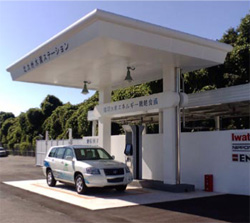Home > Highlighting JAPAN > Highlighting Japan JULY 2011 > Stepping Stones to "Smart"ness
Highlighting JAPAN
COVER STORY: Embracing New Energy
Stepping Stones to "Smart"ness
Kitakyushu in Fukuoka Prefecture is a city of a million people situated in the far north of the main island of Kyushu. The city is currently running a number of forward-thinking environmental projects aimed at achieving a low-carbon society, including a verification project for the Kitakyushu Smart Community Creation Project, launched last year. Masaki Yamada reports.

A fuel-cell car recharges at Kitakyushu Hydrogen Town. The hydrogen used is generated at Nippon Steel's Yahata refinery nearby.
Credit: COURTESY OF KITAKYUSHU CITY
In 1997, the Government approved the Kitakyushu Eco-Town Project, with a view to building a resource recycling-oriented society that reduces waste to zero by utilizing all waste products of one industry as the raw materials of another industry. In the Hibikinada area, Wakamatsu, situated in the city's north, for example, there are various recycling businesses engaging in PET bottle recycling, electric appliance recycling and automated recycling, as well as research organizations such as universities.
In another initiative, the Kitakyushu Hydrogen Town project was newly launched in January 2011. The project marks a world-first attempt to use a pipeline to supply the hydrogen generated in the iron manufacturing process at iron foundries to operate fuel cells. The Fukuoka Prefectural government and major city gas utilities are conducting demonstration testing on a joint basis. Spanning a total length of 1.2 km, the pipeline connects hydrogen stations with Kitakyushu Hydrogen Town in the Higashida district of Yahatahigashi Ward. In the Higashida district, fourteen pure hydrogen fuel cells are installed in a housing complex (comprising seven households), museum, home improvement center and other locations. These fuel cells generate electricity by combining hydrogen and oxygen. By using this system, the locations being supplied the electricity have successfully covered between twenty and sixty percent of their electricity demands without producing CO2 at the time of generation through the use of cogeneration.
Citizen Participation
Kitakyushu City has also started the Kitakyushu Smart Community Creation Project. In response, the Higashida district is investing 16.3 billion yen over the five-year period from fiscal 2010 to fiscal 2014 in the Project, which is founded on a basic plan to (1) adopt renewable energies such as solar power generation on a large scale; (2) establish a consumer-participatory energy system by means of a smart grid; (3) reduce energy consumption in places such as homes and buildings; (4) introduce electric vehicles and fuel-cell cars on a large scale; and (5) engage in highly comfortable and convenient town development through these activities. (Kitakyushu Hydrogen Town is also a part of the demonstration project.)
"One of the characteristics of this project is the participation of citizens in the use of energy. A system known as a smart grid has been extremely important in promoting participation on the part of citizens," says Taihei Shibata, director of the Smart Community section at the Kitakyushu City Office for Environmental Future City Promotion. "A smart grid is a system which optimizes the demand and supply of regional electricity by utilizing IT technologies that revolve around regional energy-saving stations."
Regional energy-saving stations are the control centers responsible for operating the smart grid. In concrete terms, information such as electricity rates and energy-saving guidance based on the demand-supply situation for regional energy flows from these energy-saving stations to homes and offices, and consumers pick up this information at display terminals through next-generation electric power meters known as smart meters. In reverse, information on electricity usage and the status of in-house solar power generation is consolidated from the consumer side to the regional energy-saving station. Through the efficient use of power based on the information sent from the regional energy-saving stations, consumers not only contribute to the stable usage of power across the entire region, but can also enjoy benefits for themselves, including reduced electricity rates by using power in a "smart" manner.
The Higashida district has already achieved a 30% reduction in CO2 emissions compared with regular districts in the city, and through the demonstration testing seeks to reduce emissions by at least 20% more.
"The Smart Community Creation Project envisages four scenarios, namely smart life, smart offices, smart mobility and smart factories. We plan to use the demonstration results in Higashida district as stepping-stones to expanding the project to all areas of Kitakyushu. In addition, we are also thinking of translating the expertise and results gained through this experience to business-related areas, particularly in the Asia region," explains Shibata.
© 2009 Cabinet Office, Government of Japan






